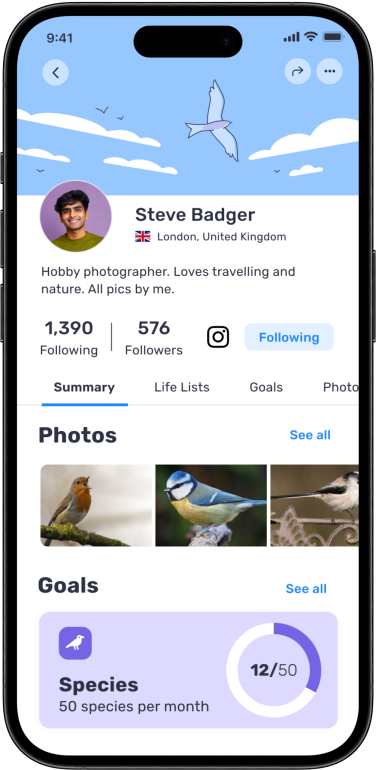loading...
Finches, Euphonias
True finches are a sizable group of small to medium-sized birds belonging to the family Fringillidae, which consists of over 200 species in 50 genera, including cardueline finches, siskins, canaries, redpolls, serins, grosbeaks, and euphonias. These birds are characterized by stout, conical bills suited for seed and nut consumption and often display vibrant plumages. Finches have a near-global spread, avoiding only Australia, polar regions, and some islands, and generally don't migrate, adapting to a variety of habitats from woods to mountains to deserts.
Although various species outside the family are also referred to as "finches," such as estrildid finches, some Old World buntings, New World sparrows, and the Galapagos' Darwin's finches (now classified as tanagers), true Fringillidae finches have a notable history and complexity in their classification, with recent DNA studies reshaping our understanding of their taxonomy, leading to reclassifications and the identification of close relationships between species groups previously placed in separate families, such as the Hawaiian honeycreepers.
Previously used in the coal mining industry as detectors of carbon monoxide, finches and canaries contributed to human safety until the practice ceased in the UK in 1986. Today’s Fringillidae family is divided into three subfamilies, with a range of body sizes from the small Andean siskin to the larger grosbeaks, and diets that vary from primarily seeds to diverse diets including arthropods and berries, as seen in the Hawaiian honeycreepers. These birds typically have strong, melodious singing capabilities, with some being popular as cagebirds, like the domesticated canary. Finch classification is a complex field marked by convergent evolution and adaptive radiation, leading to a wide variety of bill shapes and feeding adaptations. Despite their wide distribution, fossil remains are rare, suggesting a Middle Miocene origin. The name "Fringillidae" is derived from the common chaffinch, a prevalent member throughout Europe.
Regions
Categories
All
Accentors
African & New World Parrots
Albatrosses
Auks
Austral Storm Petrels
Barn Owls
Bee-eaters
Bulbuls
Buntings
Bustards
Caracaras, Falcons
Cardinals & Allies
Chats, Old World Flycatchers
Cisticolas & Allies
Cockatoos
Cormorants, Shags
Coursers, Pratincoles
Cranes
Crows, Jays
Cuckoos
Ducks, Geese, Swans
Figbirds, Orioles, Turnagra
Finches, Euphonias
Flamingos
Frigatebirds
Gannets, Boobies
Goldcrests, Kinglets
Grassbirds & Allies
Grebes
Guineafowl
Gulls, Terns, Skimmers
Herons, Bitterns
Hoopoes
Hummingbirds
Ibises, Spoonbills
Indigobirds, Whydahs
Jacanas
Kingfishers
Kites, Hawks, Eagles
Larks
Laughingthrushes & Allies
Leaf Warblers & Allies
Longspurs, Snow Buntings
Loons
Mockingbirds, Thrashers
New World Sparrows
New World Vultures
New World Warblers
Nightjars
Northern Storm Petrels
Nuthatches
Old World Parrots
Old World Sparrows, Snowfinches
Oropendolas, Orioles, Blackbirds
Ospreys
Owls
Oystercatchers
Pelicans
Penduline Tits
Penguins
Petrels, Shearwaters, Diving Petrels
Pheasants & Allies
Pigeons, Doves
Plovers
Rails, Crakes & Coots
Reed Warblers & Allies
Rollers
Sandgrouse
Sandpipers, Snipes
Sheathbills
Shrikes
Skuas
Starlings, Rhabdornis
Stilts, Avocets
Stone-curlews, Thick-knees
Storks
Swallows, Martins
Swifts
Sylviid Babblers
Tanagers & Allies
Thrushes
Tits, Chickadees
Treecreepers
Tropicbirds
Tyrant Flycatchers, Calyptura
Vireos, Greenlets, Shrike-babblers
Wagtails, Pipits
Waxbills, Munias & Allies
Waxwings
Weavers, Widowbirds
Woodpeckers
Wrens
Yellow-breasted Chat

American Goldfinch
Spinus tristis

Arctic Redpoll
Acanthis hornemanni

Atlantic Canary
Serinus canaria
Azores Bullfinch
Pyrrhula murina

Brambling
Fringilla montifringilla

Brimstone Canary
Crithagra sulphurata

Bullfinch
Pyrrhula pyrrhula

Cape Canary
Serinus canicollis

Chaffinch
Fringilla coelebs

Common Redpoll
Acanthis flammea

Common Rosefinch
Carpodacus erythrinus

Crossbill
Loxia curvirostra

Evening Grosbeak
Hesperiphona vespertina

Goldfinch
Carduelis carduelis
Gran Canaria Blue Chaffinch
Fringilla polatzeki

Greenfinch
Chloris chloris

Hawfinch
Coccothraustes coccothraustes

Linnet
Linaria cannabina

Parrot Crossbill
Loxia pytyopsittacus

Pine Grosbeak
Pinicola enucleator

Pine Siskin
Spinus pinus

Purple Finch
Haemorhous purpureus

Serin
Serinus serinus

Siskin
Spinus spinus
Tenerife Blue Chaffinch
Fringilla teydea

Trumpeter Finch
Bucanetes githagineus

Two-barred Crossbill
Loxia leucoptera

Yellow Canary
Crithagra flaviventris

Yellow-fronted Canary
Crithagra mozambica
Your birdwatching journey like never before
Connect with nature in minutes
Take a walk, look out of the window and log the birds that you see. Feel good about those little connections to nature.
Discover the joy of birding
Find new birding spots, see more birds, share and celebrate with a like-minded community of nature lovers.
Play your part in saving nature
Logging your birding sightings and sessions turns into positive action for our planet. Every sighting counts.























